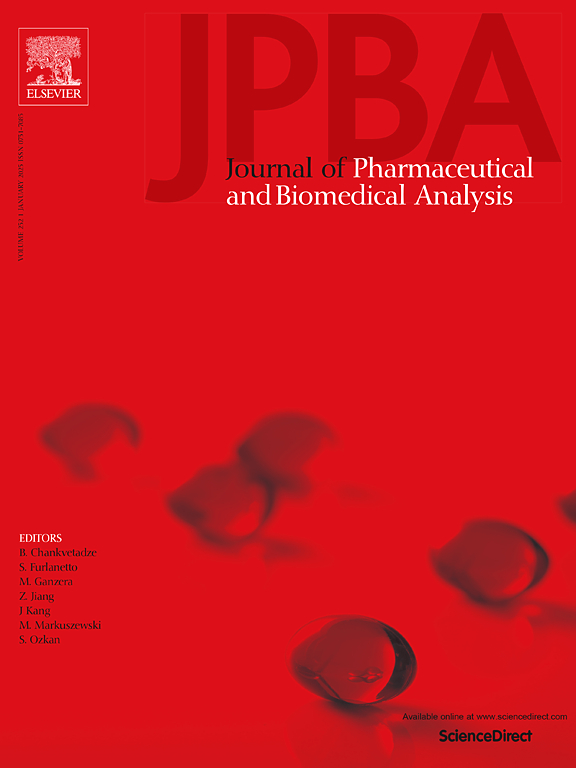Simultaneous determination of 13 representative saponins from the total saponins of Gynostemma pentaphyllum in rat plasma using LC-MS/MS for pharmacokinetic study
IF 3.1
3区 医学
Q2 CHEMISTRY, ANALYTICAL
Journal of pharmaceutical and biomedical analysis
Pub Date : 2025-05-15
DOI:10.1016/j.jpba.2025.116970
引用次数: 0
Abstract
As a plant with a rich history of medicinal and dietary use, Gynostemma pentaphyllum (Thunb.) Makino is predominantly characterized by the gypenosides. Contemporary research has demonstrated that these saponins possess significant hypolipidemic and hypoglycemic effects. This study focused on developing an LC-MS/MS approach to elucidate the pharmacokinetic profiles of 13 gypenosides in rat models. The separation was accomplished using a ZORBAX Eclipse Plus C18 column (2.1 mm × 100 mm, 1.8 µm). Detection was facilitated by employing positive electrospray ionization (ESI) in multiple reaction monitoring (MRM) mode. The analytical method was fully validated, including selectivity, linear response, measurement precision, analytical accuracy, extraction efficiency, matrix interference, and sample stability. The lower limit of quantification (LLOQ) for all compounds was 10 ng/mL, with each exhibiting a favorable linear relationship (r ≥ 0.9960). The precision, as measured by the relative standard deviation (RSD) for intra-day and inter-day variability, did not exceed 8.41 %. The accuracy, expressed as the relative error (RE), varied from −4.42–8.42 %. The recovery rate of the extraction process was between 92.02 % and 114.77 %, and no notable matrix effects were detected. The stability of the compounds was confirmed under four distinct storage conditions. Pharmacokinetic results indicated that all analytes displayed rapid absorption, prolonged retention, and slow elimination in rats, and exhibited nonlinear pharmacokinetics at low, medium, and high dosage levels. This study has established a quantification method for 13 gypenosides and successfully applied it to their pharmacokinetic studies in rats, providing a foundation for their further development and utilization.
采用LC-MS/MS同时测定大鼠血浆中绞股蓝总皂苷中13种代表性皂苷的药动学研究
绞股蓝(Gynostemma pentaphyllum)是一种具有丰富药用和食用历史的植物。牧野的主要特点是绞股蓝苷。当代研究表明,这些皂苷具有显著的降血脂和降糖作用。本研究旨在建立一种LC-MS/MS方法来阐明13种绞股蓝皂苷在大鼠模型中的药动学特征。采用ZORBAX Eclipse Plus C18色谱柱(2.1 mm × 100 mm, 1.8 µm)进行分离。在多反应监测(MRM)模式下,采用正电喷雾电离(ESI)便于检测。对分析方法进行了选择性、线性响应、测量精度、分析准确度、提取效率、基质干扰、样品稳定性等方面的验证。各化合物的定量下限(LLOQ)均为10 ng/mL,且均呈良好的线性关系(r ≥ 0.9960)。精确度,作为相对标准偏差(RSD)测量日内和日内变异性,不超过8.41 %。准确度,表示为相对误差(RE),在−4.42-8.42 %之间变化。提取率在92.02 % ~ 114.77 %之间,未发现明显的基质效应。在四种不同的贮存条件下证实了化合物的稳定性。药代动力学结果表明,所有分析物在大鼠体内均表现出快速吸收、长时间滞留和缓慢消除的特点,且在低、中、高剂量水平下均表现出非线性药代动力学。本研究建立了13种绞股蓝总苷的定量方法,并成功应用于其在大鼠体内的药代动力学研究,为其进一步开发利用奠定了基础。
本文章由计算机程序翻译,如有差异,请以英文原文为准。
求助全文
约1分钟内获得全文
求助全文
来源期刊
CiteScore
6.70
自引率
5.90%
发文量
588
审稿时长
37 days
期刊介绍:
This journal is an international medium directed towards the needs of academic, clinical, government and industrial analysis by publishing original research reports and critical reviews on pharmaceutical and biomedical analysis. It covers the interdisciplinary aspects of analysis in the pharmaceutical, biomedical and clinical sciences, including developments in analytical methodology, instrumentation, computation and interpretation. Submissions on novel applications focusing on drug purity and stability studies, pharmacokinetics, therapeutic monitoring, metabolic profiling; drug-related aspects of analytical biochemistry and forensic toxicology; quality assurance in the pharmaceutical industry are also welcome.
Studies from areas of well established and poorly selective methods, such as UV-VIS spectrophotometry (including derivative and multi-wavelength measurements), basic electroanalytical (potentiometric, polarographic and voltammetric) methods, fluorimetry, flow-injection analysis, etc. are accepted for publication in exceptional cases only, if a unique and substantial advantage over presently known systems is demonstrated. The same applies to the assay of simple drug formulations by any kind of methods and the determination of drugs in biological samples based merely on spiked samples. Drug purity/stability studies should contain information on the structure elucidation of the impurities/degradants.

 求助内容:
求助内容: 应助结果提醒方式:
应助结果提醒方式:


